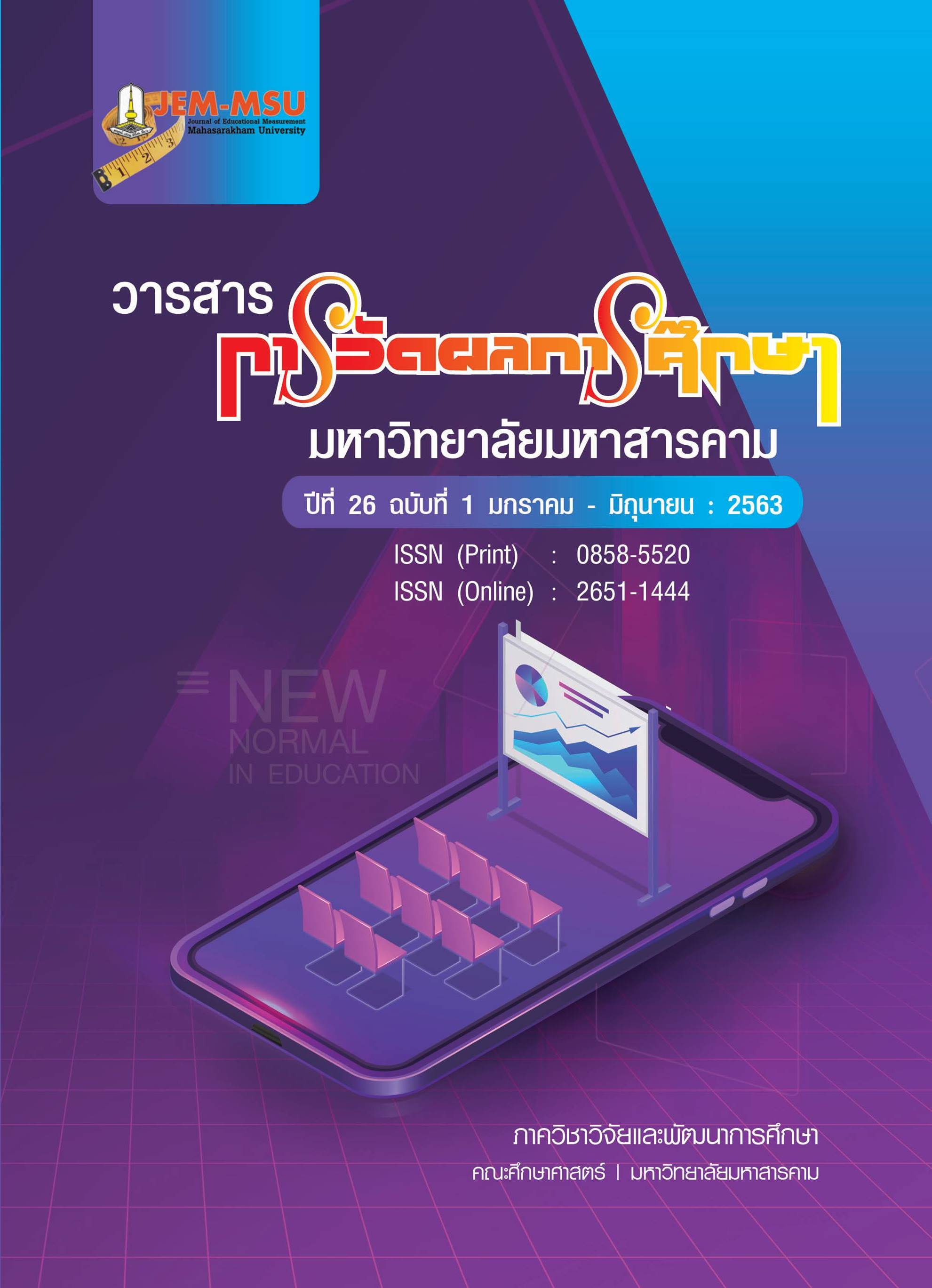Confirmatory Factor Analysis of the Scale Measuring Creativity disposition of Thai innovators
Main Article Content
Abstract
The purpose of this research was to develop indicators and examine the construct validity of the scale measuring creativity disposition of Thai innovators. The sample consisted of 162 Thai innovators (108 males and 54 females) who responded to the 27 items of creativity disposition scale developed by the researcher. Confirmatory factor analysis was employed in the analysis of data.
The results of the research were as follows: 1) the creativity disposition of Thai innovators consists of 8 indicators: 1.1) exposure to new knowledge and experience, 1.2) learning characteristics, 1.3) liking for thinking and solving problems, 1.4) characteristics of values and beliefs, 1.5) characteristics of creation and working, 1.6) self-image, 1.7) characteristics of motivation 1.8), characteristics of emotions and feelings. 2) The first confirmatory factor analysis found that the model for measuring the creativity disposition of Thai innovators was consistent with the empirical data. The value of the goodness of fit test statistics were as follows: 2 (17, N=162) = 15.74, p = .54, CFI (comparative fit index) =1.00 TLI (Tucker-Lewis index) = 1.00 , SRMR (standardized root mean square residual) = .02, RMSEA( root mean square error of approximation) = .00, AIC (Akaike information criterion) = 1929.68 and
2/df = 0.93. And it was found that the composition weight of every indicator was statistically significant (p <.01). The composition weight value in the standard score was between .66 - .88. The indicator having significant weight and could explain the creativity disposition of Thai innovators most was the characteristics of creation and working (β = .88, R2 = .77). Meanwhile, 2 indicators could explain the creativity disposition of Thai innovators least were characteristics of motivation, and characteristics of emotions and feelings (β = .66, R2 = .44).
Article Details
The content and information contained in the published article in the Journal of Educational Measurement Mahasarakham University represent the opinions and responsibilities of the authors directly. The editorial board of the journal is not necessarily in agreement with or responsible for any of the content.
The articles, data, content, images, etc. that have been published in the Journal of Educational Measurement Mahasarakham University are copyrighted by the journal. If any individual or organization wishes to reproduce or perform any actions involving the entirety or any part of the content, they must obtain written permission from the Journal of Educational Measurement Mahasarakham University.
References
ณัฐพงษ์ เจริญพิทย์. (2542). การศึกษาลักษณาการนักคิดสร้างสรรค์และขั้นตอนการคิดสร้างสรรค์ กรณีนักวิทยาศาสตร์รุ่นใหม่ นักเรียนวิทยาศาสตร์กลุ่มคัดสรร ผู้ใหญ่นักประดิษฐ์ และนักเรียนนักประดิษฐ์. กรุงเทพฯ : คณะศึกษาศาสตร์ มหาวิทยาลัยศรีนครินทรวิโรฒ.
นงลักษณ์ วิรัชชัย. (2555). การกำหนดขนาดตัวอย่างและสถิติวิเคราะห์ใหม่ ๆ ที่น่าสนใจ. เอกสารประกอบการ บรรยาย ‘Twilight Program’ การนาเสนอผลงานวิจัยแห่งชาติ 2555 (Thailand Research EXPO 2012) ณ ศูนย์ประชุมบางกอกคอนเวนชั่นเซ็นเตอร์ เซ็นทรัลเวิร์ล ราชประสงค์ กรุงเทพมหานคร วันเสาร์ที่ 25 สิงหาคม 2555 เวลา 18.00-20.00 น.
วีรพล แสงปัญญา. (2548). การศึกษาบุคลิกลักษณะ กระบวนการคิดสร้างสรรค์ และผลงานการสร้างสรรค์ : กรณีศึกษาบุคลผู้สร้างสรรค์ชาวไทยที่มีผลงานโดดเด่นในสาขาวิทยาศาสตร์ ศิลปะ และการศึกษา. วารสารประชากรศาสตร์ จุฬาลงกรณ์มหาวิทยาลัย, 21(1) (มีนาคม 2548), 63-85.
สานักนายกรัฐมนตรี. (2560). สรุปสาระสำคัญแผนพัฒนาเศรษฐกิจและสังคมแห่งชาติฉบับที่สิบสอง พ.ศ.2560 -2564. สานักงานคณะกรรมการพัฒนาการเศรษฐกิจและสังคมแห่งชาติ.
Barron, F.and Harrington. D.M. (1981). Creativity, intelligence, and personality. Annual Review of Psychology. 32, 439 – 476.
Berlina, M., Tavanib, J-L., and Beasançonc, M. (2016). An Exploratory Study Of Creativity, Personality and Schooling Achievement. Education Economics, 24.
Clark, B. (1997). Growing up Gifted: Developing the Potential of Children at Home and at School. New Jersey: Prentice-Hall.
Colangelo, N. and Davis, G. A. (1991). Introduction and historical overview. In N. Colangelo and G. A. Davis. Handbook of Gifted Education. Massachusetts: Needham Heights.
Cropley, A.J. (2000). Defining and measuring creativity: Are creativity test worth using? Roeper Review, 23(2), 72-80.
Davis, G. A., and Rimm, S. B. (1994). Creativity: The creative person, creative process and creative dramatics. In Needham, Education of the Gifted and Talented. Heights: Alllyn and Bacon.
Katz, L.G. (1993). Dispositions as educational goals. ERIC Digest EDO-PS-93-10. Urbana, IL: ERIC Clearinghouse on Elementary and Early Childhood Curriculum.
Lubart, Todd, and Christophe Mouchiroud. (2003). “Creativity: A Source of Difficulty in Problem Solving.” In The Psychology of Problem Solving, edited by Janet E.Davidson, and Robert J Sternberg, 127–148. Cambridge: Cambridge University Press.
Malakula, Prasarn. (1974). Personological Correlates of Creative Productivity in Thai Students Dissertation, The University of Wisconsin – Madison
Meador, S. Karen. (1997). Creative Thinking and Problem Solving for Young Learners. Englewood Colorado Teacher Ideas Press,
Ochse, R. A. (1990). Before the Gates of Excellence: The Determinant of Creative Genius. New York: Cambridge University Press,
Olszenwski-Kubilius. (2000). The transition from childhood giftedness to adult creative productiveness: Psychological characteristics and social. Roeper Review, 23(2), 61-71.
Piirto, J. (1994). Talented Children and Adults: Their Development and Education. New York: Macmillan Publishing,
Piirto, J. (1998). Understanding Those Who Create. United State: Great Potential Press Inc,
Uwe, W., and Jean, E. P. (2001). Individual difference in creativity: Personality, story writing, and hobbies. European journal of personality, 15, 297-310.


